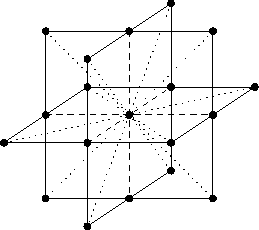The Multi-Speed Model was introduced by d'Humières et al.
[20]. It uses a regular cubic lattice and has particles
travelling with three different velocities: zero, unity and ![]() . Such
a lattice is shown in figure 3-5.
. Such
a lattice is shown in figure 3-5.

Figure 3-5: A cubic
lattice. The solid lines show the planes x=0, y=0 and
z=0 through the sites which are represented by solid dots. The central
site is connected to its six nearest neighbours by the dashed links, and to
its twelve next-nearest neighbours by the dotted links
The rest particles remain stationary at the sites, the unit velocity
particles travel to the nearest neighbours along the dashed links and
the ![]() velocity particles travel to the next-nearest neighbours
along the dotted links. The collision rules conserve mass and momentum
at each site: two particles approaching head on collide and move
off at right angles (as in the HPP model but here there are two possible
outcomes, one of which is picked at random), two unit speed particles colliding
at right angles produce a rest particle and a
velocity particles travel to the next-nearest neighbours
along the dotted links. The collision rules conserve mass and momentum
at each site: two particles approaching head on collide and move
off at right angles (as in the HPP model but here there are two possible
outcomes, one of which is picked at random), two unit speed particles colliding
at right angles produce a rest particle and a ![]() particle
travelling so as to
conserve momentum.
Conversely, when a
particle
travelling so as to
conserve momentum.
Conversely, when a ![]() particle and a rest particle collide two
unit speed particles are produced.
particle and a rest particle collide two
unit speed particles are produced.